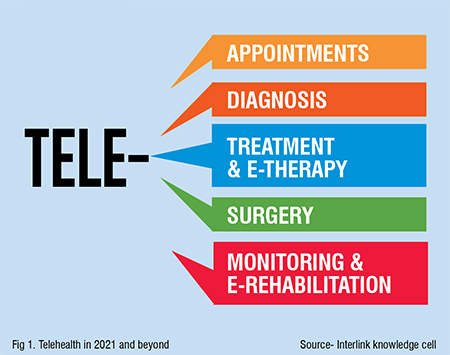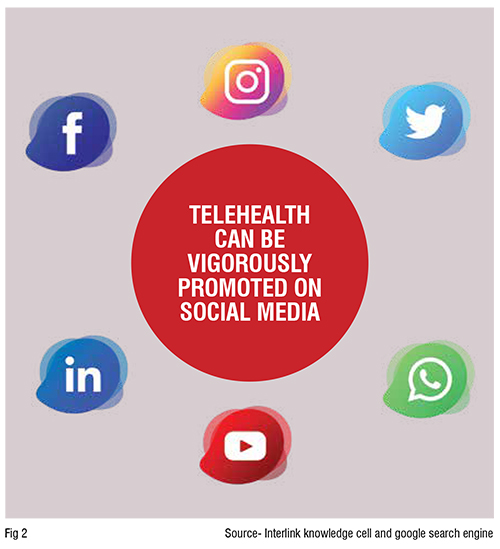Constantly declining volume of patients visiting hospitals and rise in adoption of telehealth, the new era in medical practices is expected to show the journey of patients and physicians from Telehealth appointments to Teletreatment & recovery in 2021. The year will be occupied with innovative marketing actions in medical practices and patient education programs in hospitals to help patients to be digitally savvy and much healthier.
Physical appointments, even referrals, have been declined due to pandemic as there was no active and physical consulting going on. It has affected both in-house patients as well as outdoor patients.
This is leading stakeholders toward telehealth platforms which are emerging at a rapid pace in various hospitals and private clinics, enabling the hospitals to expand their services in multiple and beneficial ways.
Tele-ICUs are one of the biggest examples arising in today’s scenario, where a number of hospitals placed at distant from one another, are able to communicate with hospital critical care units and achieve real-time services via technological advancements.
Surging incidences of infectious disease is the factor shaping patients’ mindset in such a way that they are obliged to choose a virtual platform, making hospitals rethink their old practice and service models. Although, quite a good number of healthcare systems have become well-equipped with this new platform, many are still struggling to maintain their identity in this new normal of healthcare practices. Reasons might be many — lack of right awareness about the platform, overreliance on old practices and service models, weak promotional tactics, etc.
This could be solved with new hospital practices and educating patients and caregivers in a right and beneficial way.
2021 will be the year filled with technology related initiatives; much more than ever seen in healthcare history. Telehealth is the area which will be featured in possibly advanced, profitable and patient-friendly manner and will be equipped with all those viable strategies to conquer any inevitable incidences like COVID-19.
Following are the components of telehealth through which hospitals are evolving and will continue to evolve in 2021 and beyond.
These have turned out to be an amazing option in the pandemic. Tele-appointment is the facility which was earlier seen at the hospitals with huge infrastructure. But the situation is different nowadays. Many reasons associated with COVID fear are fuelling the need for hospitals to adopt Tele-appointment technology even if the infrastructure is not huge. After all everyone wants to be in the race!
Physicians are carrying out telemedicine appointments, getting a look into their patient's health without ever having to see them in the hospital. This is helping elders and patients with chronic conditions, making a big revolution in healthcare practices.
This technology is showing impressive gains in providing services and giving entry to the medically inaccessible areas where hospital services are difficult to reach, ultimately propelling the establishment of telemedicine hospital centres in various rural areas.
Screening multiple patients is now possible while maintaining the treatment of others. Technologies such as China’s virtual diagnosis of coronavirus using 5G network are rooting in hospitals giving relief to physicians, hospital staff and patients regarding possible spread of infection.
Nowadays, ESA-supported robotics technology making good moves in radiology examination. This system is already in force in Europe and Canada for examining heart, abdominal, pelvic, and urinary tract diseases remotely. Using video conferencing, radiologists and cardiologists are remotely moving robotic arms and adjusting settings to capture best possible images. These technologies are incredibly helpful while dealing with COVID patients with other allied health issues.
Research to develop the best technology-based methods to provide virtual diagnosis, where necessary hardware installation in hospitals to make telediagnosis possible will always be the matter of concern for many underdeveloped hospitals.

Real-time interaction with the specialists is making it easy to get proper and timely treatment and therapies making patients and hospitals more adaptive toward telehealth.
Many hospitals have adopted the digital way of prescribing i.e., E-prescribing which is constantly increasing and the market is its expected growth at a CAGR of 23.3 per cent, will reach US$ 3.3 billion by 2025. So ultimately, tele-treatments are opening the doors wide open for the already emerging E-pharmacy sector.
Various E-therapies are becoming more and more promising. Impressive moves are seen in E-psychotherapy, where psychiatrists are directly engaging themselves in patients’ rooms virtually and taking deep insights about patients’ problems and recovery.
Although many delicate surgeries are performed aboard, tele-health and technologies are helping patients and surgeons in the hospitals to be at their own location and operate the surgeries efficiently.
Hospitals having 5G network and robot-assisted equipment and hardware will provide fast data transfers with little to no latency in the procedure giving excellent outputs while performing virtual surgeries.
Post-surgery monitoring is always important after a patient is discharged. Hospitals are now evolving in the field of post-surgery consultation. Telemonitoring provides a better option to virtually meet the physician while lying on the bed at home, without struggling with paining stitches on the way to hospital. Elderly patients or patients with decreased mobility are extensively monitored with these technologies, helping them to recover much faster.
E-rehabilitation is useful for patients with musculoskeletal conditions, multiple sclerosis, osteoarthritis, and recovery of motor function. Doctors in hospitals can monitor the movements of patients in yoga and provide therapy in a much effective manner, allowing patients to recover faster than expected.
Although many hospitals are actively participating and adopting all these technologies, some are still not using it to its full potential. Many hospitals are wellequipped with all the necessary hardware and infrastructure but are dragged down by poor marketing of services.
Following are some marketing and promotional strategies if employed by the hospitals will surely help in reaching new patients and reengaging old ones-
Vaccination of children, monitoring child growth after birth, serious injury, severe chest pain or a drug overdose, etc. are some of the cases for which the doctor needs to lay hands on a patient. Mentioning all such things shows affectionate behaviour of physicians toward patients and also builds trust.

Apollo Telehealth Services (ATHS) is the largest telemedicine network in South Asia generated by Apollo Hospitals providing a number of services to increase the access of patients toward healthcare. This network has 24*7 medical response centres consisting of physicians which are solely dedicated to Telehealth services of Apollo hospitals.
Teleclinics established by ATHS are equipped with all the required hardware and medicinal devices for the better access of patients to healthcare even in rural areas. They are currently using real-time techniques, store and forward, remote monitoring techniques to run this platform via video-conferencing, emails, wireless tools, etc.
Tele-radiology services of ATHS are transmitting X-ray images, CTs, MRIs etc. to the Apollo hospital specialists and a number of patients are getting realtime consultation and diagnosis.
Cardiologists at Apollo hospitals are providing solutions to remote medical care providers based on transmitted ECGs to them. They have multiple ECG reading centres at various locations accompanied with monitory services.
Tele-emergency care enabling the emergency care specialists of Apollo hospitals to stabilise and monitor the patients in remote hospitals. And in the space of condition management, Apollo’s remote management programs provide some tools and automated care plans in the form of mobile apps or devices related to particular conditions such as diabetes, heart disorders, highrisk pregnancy, etc.
Doc On Call at ATHS enables hospital’s IT systems to share patient’s information such as EMRs, PACS, LIS, RIS and non-clinical information like staff scheduling, nurse assignment, and ADT systems, etc. leading to establishment of connectivity between a large ecosystem of hospital specialists and patients.
Along with all this services, Tele-ICU, Tele-ophthalmology, tele-audiology, psychiatric counselling, chronic disease management, motherhood care, teleeducation, etc are also some of the demanding services given by ATHS of Apollo hospitals making good moves in Tele-health sector of hospitals.
In addition to all these, if we have a look at the website and marketing strategies employed by Apollo hospitals to promote their telehealth services, they are just amazing!
Telehealth and technology related to it are the practice changing initiatives taken by many hospitals in 2020. It is a reality and every hospital needs to accept and adopt it. Old hospital practice models will no longer remain superior. Years coming ahead are already showing the clear picture of technologybased services in every part of industry, healthcare is not an exception, hospital managements have to be ready to absorb and emit all these changes efficiently and wisely.
References:
1. Sahar Qazi, Khushnuma Tanveer, Khaled Elbahnasy, Khalid Raza_ From Telediagnosis to Teletreatment: The Role of Computational Biology and Bioinformatics in Tele-Based Healthcare_https://www.researchgate.net/publication/332874836 _From_Telediagnosis_to_Teletreatment_The_Role_of_Computational_Biology_and_Bioinformatics_in_Tele-Based_Healthcare_accessed on 21.12.2020
2. Deloitte report _accessed on 21.12.2020
3. Teresa Iafolla_7 Steps To Educating Patients About Telehealth_https://blog.evisit.com/virtual-care-blog/7-steps-educating-patients-telehealth_accessed on 23.12.2020
4. Kayla Matthews_ 6 Telemedicine Predictions For 2020_https://www.healthitoutcomes.com/doc/telemedicine-predictions-for-0001_accessed on 23.12.2020
5. https://www.fullmedia.com/10-marketing-ideas-if-you-are-launching-telemedicine-at-your-practice_accessed on 23.12.2020
6. https://www.apollotelehealth.com/_accessed on 30.12.2020